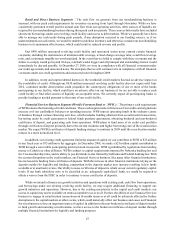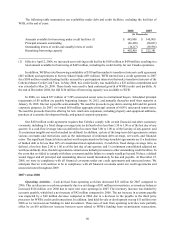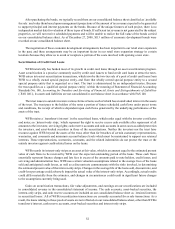Cabela's 2008 Annual Report Download - page 61
Download and view the complete annual report
Please find page 61 of the 2008 Cabela's annual report below. You can navigate through the pages in the report by either clicking on the pages listed below, or by using the keyword search tool below to find specific information within the annual report.56
Critical Accounting Policies and Use of Estimates
Our consolidated financial statements have been prepared in accordance with accounting principles generally
accepted in the United States of America which requires management to make estimates and judgments that affect
amounts reported in the consolidated financial statements and accompanying notes. Management has discussed the
development, selection, and disclosure of critical accounting policies and estimates with the Audit Committee of
Cabela’s Board of Directors. While our estimates and assumptions are based on our knowledge of current events and
actions we may undertake in the future, actual results may ultimately differ from our estimates and assumptions.
Our estimation processes contain uncertainties because they require management to make assumptions and apply
judgment to make these estimates. Should actual results be different than our estimates, we could be exposed to gains
or losses from differences that are material.
For a summary of our significant accounting policies, please refer to Note 1 of our consolidated financial
statements. We believe the accounting policies discussed below represent accounting policies we apply that are the
most critical to understanding our consolidated financial statements.
Merchandise Revenue Recognition
Revenue is recognized on our Internet and catalog sales when merchandise is delivered to customers at the
point of delivery, with the point of delivery based on our estimate of shipping time from our distribution centers
to the customer. We recognize reserves for estimated product returns based upon our historical return experience
and expectations. Had our estimate of merchandise in-transit to customers and our estimate of product returns
been different by 10% at the end of 2008, our operating income would have been higher or lower by approximately
$2 million. Sales of gift instruments are recorded in merchandise revenue when the gift instruments are redeemed
in exchange for merchandise and as a liability prior to redemption. We recognize breakage on gift instruments as
revenue when the probability of redemption is remote. Historically, the Company recognized breakage seven years
after the issuance of a gift certificate or gift card. In the fourth quarter of 2008, we began recognizing breakage
income on gift instruments four years after issuance as a result of changes in historical trends in the types of gift
instruments issued and the related redemption rates. The impact of the change in estimate in the fourth quarter of
2008 was an increase in revenue and operating income of approximately $9 million. Had our estimate of breakage
on our recorded liability for gift instruments been different by 10% of the recorded liability at the end of 2008, our
operating income would have been higher or lower by approximately $11 million.
Inventories
We estimate provisions for inventory shrinkage, damaged goods returned values, and obsolete and slow-moving
items based on historical loss and product performance statistics and future merchandising objectives. While we do
not believe there is a reasonable likelihood there will be a material change in the future impacting these estimates,
actual losses can be higher or lower based on future merchandising decisions and retail economic trends. Had our
estimated inventory reserves been different by 10% at the end of 2008, our cost of sales would have been higher or
lower by approximately $1 million.
Catalog Costs
Deferred catalog costs consist of incremental internal and third-party direct costs incurred in the development,
production, and circulation of our direct mail catalogs, composed principally of creative design, prepress/production,
paper, printing, postal, and mailing costs. Deferred catalog costs are amortized over their expected period of future
benefit or twelve months, whichever is shorter, based upon sales forecasts developed using historical sales for similar
catalog offerings. Deferred catalog expenses are evaluated for recoverability at each reporting period by comparing
the carrying amount associated with each catalog to actual sales data and to projected future cash flows. Had our
amortization estimate of deferred catalog costs been different by 10% for 2008, our catalog costs expense would have
been higher or lower by approximately $2 million.
























